An Introduction to Special Economic Zones in Bangladesh
An insight into Bangladesh’s present economic state of affairs
On September 3, Australian Foreign Minister Marise Payne met her Bangladeshi counterpart Dr AK Abdul Menon and Prime Minister (PM) Sheikh Hasina in Dhaka. Economic development was a significant subject of discussion at the meeting, this included investments in Bangladesh’s Special Economic Zones (SEZ’s). Furthermore, in mid-September a Bangladeshi Member of Parliament (MP) and Advisor to the Prime Minister (PM) for private industry and investment Salman Fazlur Rahman led a 20-member delegation in the UAE to attract investors into Bangladesh, followed by an announcement that Bangladeshi infrastructure projects are slated to draw investments worth an estimated USD 10 Billion from the UAE. The delegation also included officials from Bangladesh Economic Zones Authority (BEZA). Moreover, Dr Menon is slated to visit France and Germany in October 2019 to urge their companies to invest Bangladeshi SEZs.
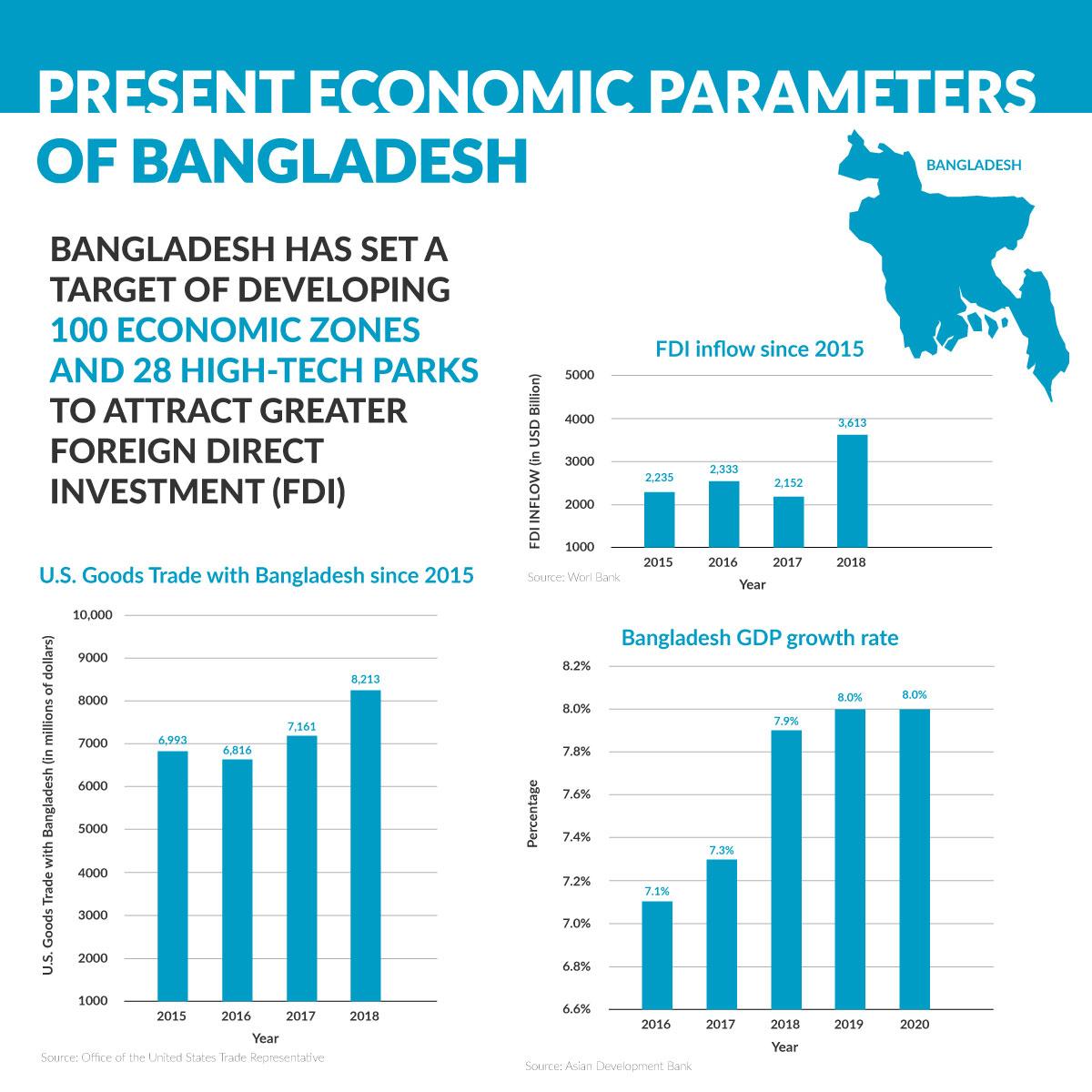
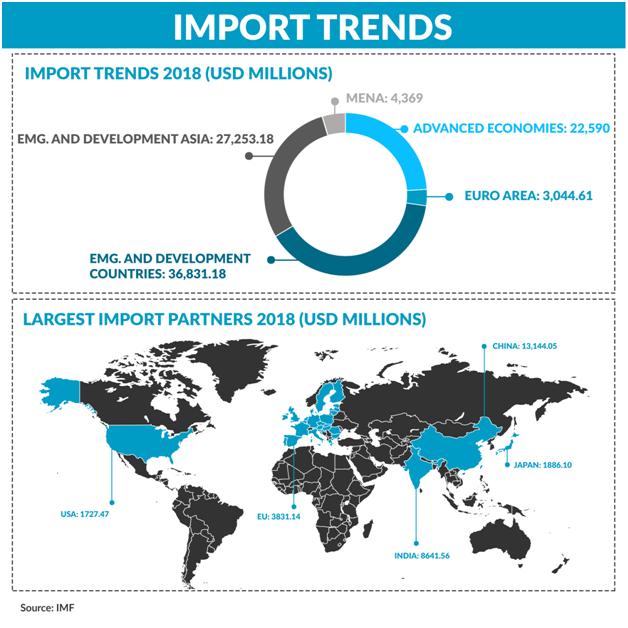
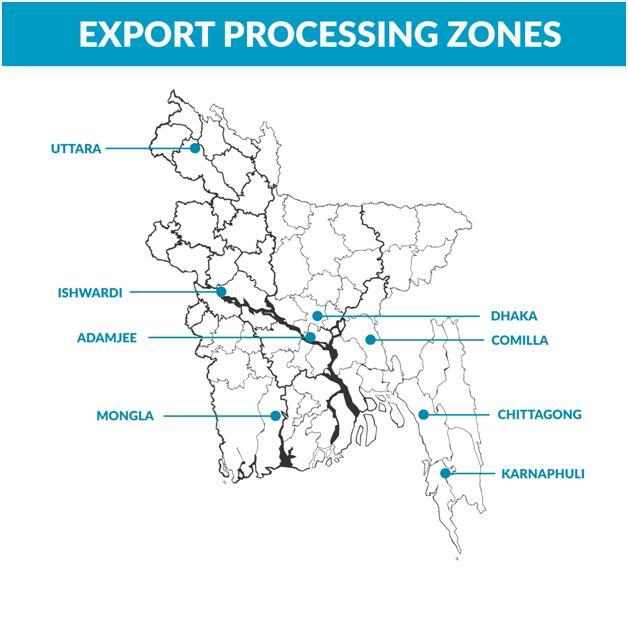
In 2010, the Awami League introduced Bangladesh Economic Zones Authority (BEZA), a centralized institution responsible for establishing and monitoring SEZs in Bangladesh. BEZA was introduced under the Vision 2021 program. The following facilities operate under BEZA:
8 Export Processing Zones (EPZs) (i.e. 8 government and 9 private);
88 zones have been approved to be established (59 government and 29 private).
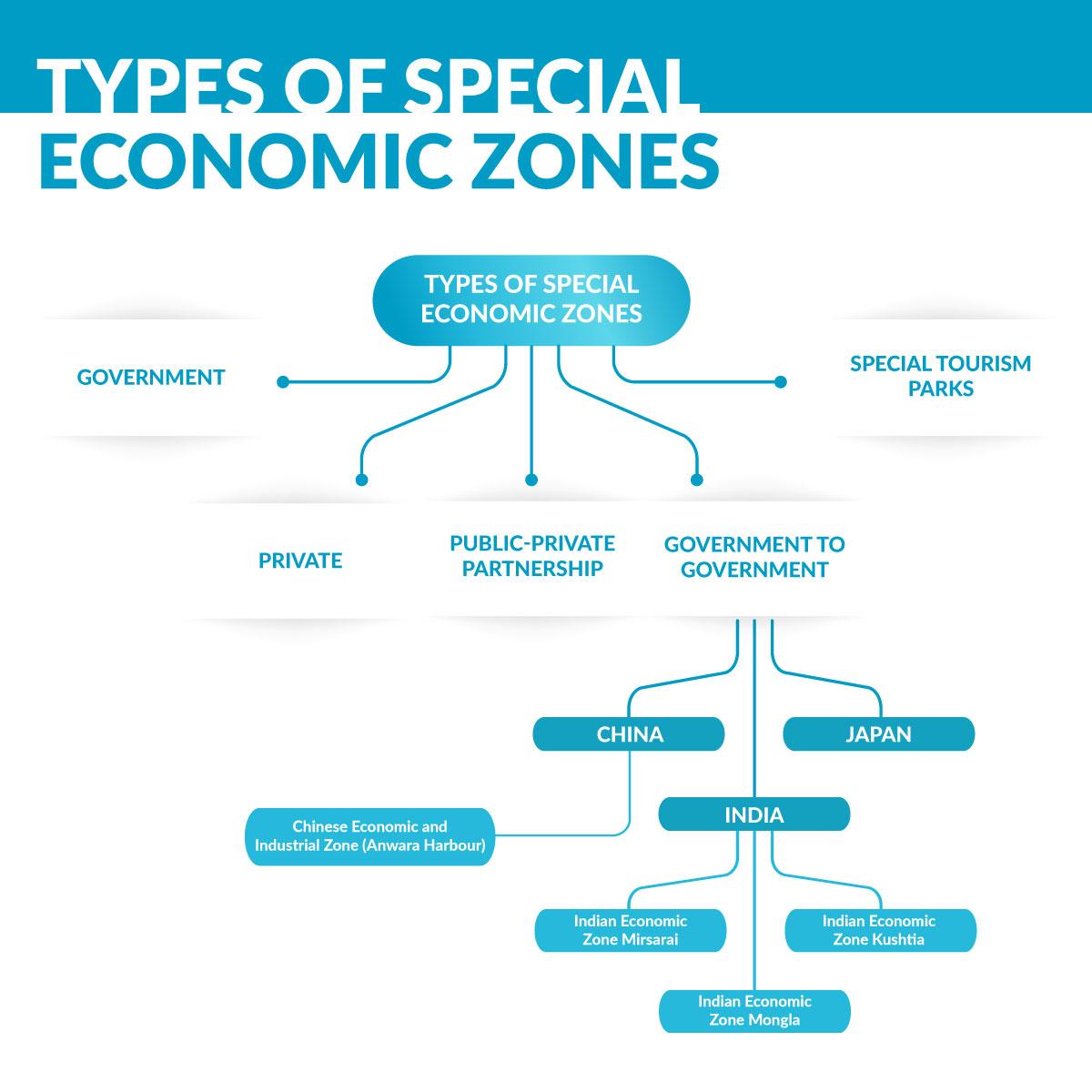
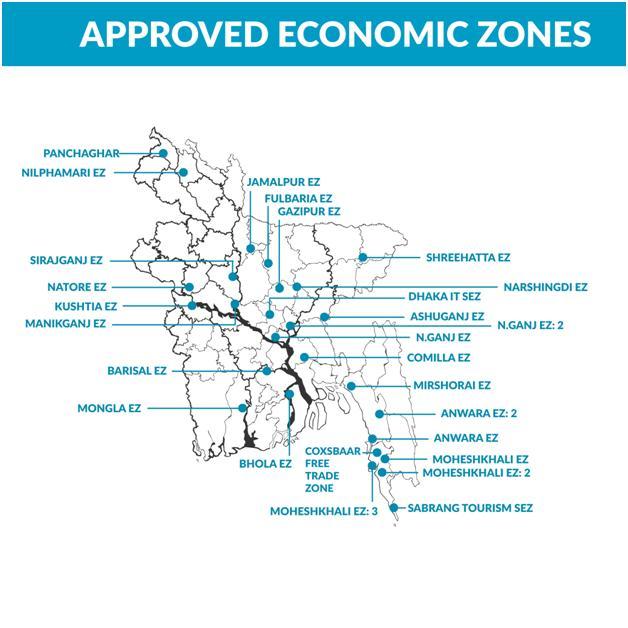
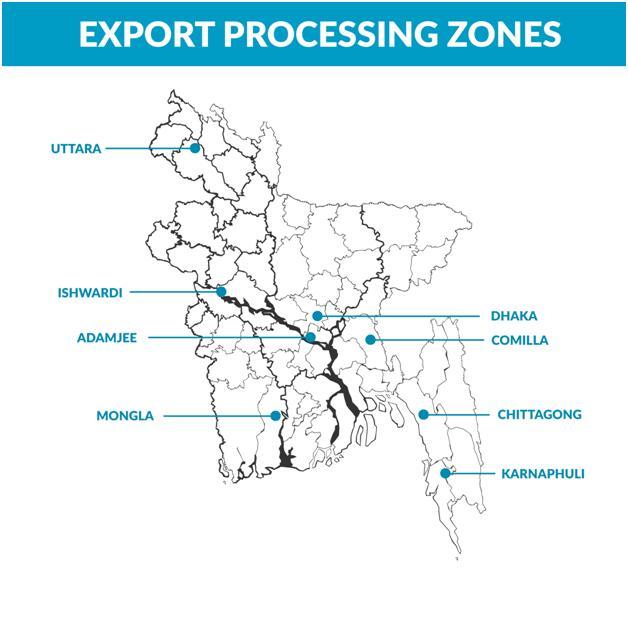
FORECAST
Bangladesh’s Current Socio-Political Scenario
• Politics Incumbent Awami League’s Grand-Alliance Government: Sheikh Hasina’s victory in the Bangladeshi General Elections held in December 2018 has placed her in a position of strength in Bangladesh’s political environment. The primary opposition factions consisting of Bangladeshi Nationalist Party (BNP) and the conservative factions opposing AL rejected the results of the election, however, given the primacy of Sheikh Hasina’s government and ALs popularity, the gesture of BNP and its allies had negligible impact. Moreover, former PM and BNP chairperson Khalida Zia has been imprisoned for 17 years due to alleged corruption charges. Thus, the footprint of the mandate(s) adopted by the AL government will have a significant impact over the next five years. Economic development involving the state’s international and domestic policies is one such parameter. Despite the stability of the government, certain parameters remain a matter of concern in Bangladesh, the most prevalent among its failures is to prevent corruption. International corruption indices score Bangladesh particularly low, for instance Transparency International ranks Bangladesh 149 out of 180 allocating a score of 26 out of 100. The report states that corruption among bureaucracy are commonplace at junior levels and certain institutions as well. The Anti-Corruption Commission (ACC) Bangladesh was formed in 2004, however the organization has been deemed inefficient in combating corruption. Furthermore, an amendment passed in 2013 of the Anticorruption Commission Act passed by Awami League has made it difficult for the division to operate, whereby the government is allowed to interfere in the investigations of the unit if deemed necessary.
• Civil Unrest Movements in Bangladesh: Civil disturbances and demonstrations may occasionally transpire in Bangladesh. At the time of writing, students protested the murder of a 21 year old university student, allegedly committed by the workers of the Chhatra League, the student wing of the Awami League, reports also suggested that Bangladesh Nationalist Party (BNP) participated in the protests. Multiple instances of protests have been reported in Bangladesh since the election of Sheikh Hasina. Furthermore, the arrest of the opposition leader Khalida Zia has led to widespread anguish amongst cadres associated with the opposition (BNP and its allies). A major instance of one such outburst was prior to the 2018 elections in December with a footfall of close to 10,000 protestors in Dhaka. Student protests are also commonplace in Bangladesh, apart from the case mentioned above, a protest to promote Road Safety from August 2018, brought Dhaka to a standstill after students protested the conditions of road and the consequent traffic that led to the death of two students prior to the incident. The protest led to blocking internet access for 24 hours to avoid reports of false information with the involvement of the cyber crime division. The state police were allowed to carry out all possible safety measures required. However, protests subsided after a new law was enacted by the government.
• Poverty and overpopulation: Bangladesh ranks 7th globally in terms of population Density, with its capital Dhaka having over 20,000 inhabitants per square kilometer. Although the country has a large population, the population growth rate has declined over the years to 1 per cent as 2019. Moreover, according to World Bank reports, Bangladesh’s absolute poverty levels have reduced from 13.8% in 2016 to 9% in 2018. Increasing social indicators as well as lower cost of living is going to provide the ideal ground for an increasing population of skilled labour. However, unplanned urbanization may prove to be a challenge as opportunities increase.
Security
• Terror Activity: Given Bangladesh’s strategic location given its demographic and societal makeup, security challenges eminating from terrorism continues to remain a major challenge to the country. Despite Sheikh Hasina’s policy of Zero Tolerance to Corruption and Terror, terror activity in Bangladesh remains a problem. Organizations such as Jamaat-ul-Mujahideen, Jamaat-I-Islami, Islamic Front of Bangladesh, Ansarullah Bangla Team are among the terror groups with a large network in the country with overseas operations. International terror organizations such as Islamic State (IS) and Al-Qaeda also reportedly have networks in the country. The National Security Agency, a wing of Bangladesh’s Intelligence Community suggests the change in the modus operandi of the new terror groups who are more tech savvy in comparison to the older groups. Moreover, the increase in lone wolf attacks can be distinguished from the bombing techniques used by conventional terror groups. Furthermore, the newer groups have improved links with international terror networks and has often used cyberspace for acquisition and proliferation of ideology as well as resources for targeting. Past precedence indicate that terrorism in urban areas is a major concern, the most infamous incident taking place at the Holy Artisan Bakery in Gulshan an upmarket neighbourhood in Dhaka, where five attackers allegedly associated with Islamic State (IS) killed over 22 civilians including foreign nationals. The attackers were subsequently neutralized. Similarly, an instance in March 2017, in South Surma Upazila in the Sylhet region gained notoriety after two suicide bombers killed 4 civillians and 2 police officers while injusring many others. IS claimed responsibility once again. At the time of writing, no recorded instances of terror activity has occurred in the vicinities of SEZ’s. That being said with a pervasive threat of terror incidents in the country, one cannot rule potential dangers terror activities pose to SEZs.
• Money Laundering: Given Bangladesh’s rapidly growing foreign trade, money laundering has become a cause of concern especially for the Banking sector.
• Crime Rates: The Overseas Security Advisory Council (OSAC) of the US State Department in its report suggests considerable risk in Dhaka and other major cities of financial fraud, petty theft, cybersecurity, etc.
Geographical and Environment Factors
• Climate Change: Climate change remains a significant issue in Bangladesh. The primary concerns pertain to cyclones, droughts, constant flooding and riverbank erosion. Furthermore, as the global sea level is on a rise, environmental reports indicate that Bangladesh and its population are at extreme risk of facing consequences. Moreover, as many SEZs are planned in the vicinity of coastal areas as well as river banks, one cannot rule out the possibility of disruptions in the event of an environmental hazards including loss of life. Additionally, the Belgian organization Hugo Observatory indicates that 38 per cent of the population in Barisal and 42 per cent of the population of Chittagong could be displaced within the next 10 years. Moreover, two major SEZs India’s Mirsarai and China’s Anwara Harbour lie in the vicinity of Chittagong, along with seven others, thus making the zones prone to climatic changes.
• Operational Feasibility: Environment Review Report from the Mongla SEZ stated that the site is subjected to seasonal flooding and requires channelized drainage systems. Owing to Bangladesh’s climate, the location of an SEZ remains a matter of concern. The desirable location for an SEZ should be in the vicinity of an urban centre for adequate infrastructure, good connectivity and proximity to major financial centres. Regional disparity is another cause of concern as it includes factors like basic income, poverty incidence, educational attainment etc. in the various divisions and districts of the country. Reports from 2017 indicated that the setting up the three Indian industrial zones at Mongla, Bheramara and Misarai met with multiple complications pertaining to the infrastructure at the three sites. Some of the constraints include lack of consistent and continuous power supply at the sites as well as lack of adequate facilities to carry out operations. Furthermore, India put forward a request to allot land closer to major cities such as Dhaka and Chittagong (similar to the Chinese SEZs). However, with increasing Foreign Direct Investment (FDI) to the country, in all likelihood a significant improvement in infrastructure may be witnessed in the future.
• Increasing cost of land: Sources suggest that land costs are high in Bangladesh and gradually rising as the Nominal GDP of Bangladesh as well as FDI increases. Thus property rates for future investors are likely to appreciate.
Economic Scenario for Investments
• Liberal Investment Policies for foreign investors: Keeping in mind, the incumbent government’s economic aspirations, making Bangladesh as an attractive destination for investment has led to liberal policies for foreign investments. Some of these features include Unrestricted Exit Policy as well as 100% ownership by the foreign investor and full repatriation of dividend and capital on exit, concessionary duty on import of machinery and Duty-free market access to 52 countries including the US, Australia and India. However, Bangladesh scores low on Ease of Business ranking 176 and obtaining a score of 41.97 lower than India, Pakistan and Sri Lanka. The primary indicators that are rated low in the index include protecting minority investors, paying taxes, trading across borders, and enforcing contracts out of 10 categories.
• Labour and Labour Laws: Labour courts in Bangladesh are highly active. For instance, recently, reports indicated Economist Mohmmad Younus was tried at Dhaka 3rd labour court over an issue pertaining to the suspension of three employees at Grameen Communication where he is a Chairman. The evolving requirements of adequate labour laws follows a pattern similar to India, the proponents of these laws suggest the poor conditions of workers including reasons such as 3 out of 5 Bangladeshis finding themselves in vulnerable employment are concerns that essentially pertain to strengthen labour laws. However, one must note that there are differences in labour activity within SEZs and in Bangladesh in general. The labour laws transcribed for the mainland is also applicable for the SEZs but the implementation differ. Moreover, autonomy in recruitment decisions as well as regulatory environments are distinguishable between mainstream business activity in Bangladesh and the SEZs to enable efficiency within the SEZs. Reports indicate the health and safety conditions of workers in the garment industry, as well as other industries, are a source of concern. However, employing labour unskilled and skilled remains competitive compared to the rest of the region, posing as an advantage for businesses, for instance the minimum wages in Bangladesh is lower than others in the region including India, Myanmar, Cambodia and Vietnam at 0.09 USD per hour. Furthermore, as the manufacturing sector remains the primary driver of the economy employing over 20 million jobs invites increasing foreign investment. However, Information Technology, Shipbuilding, Tourism are key industries that have experienced considerable growth as well. Reports suggest that Bangladesh has over 200 shipbuilding companies whose offices extend throughout the country, while the World Travel and Tourism Council (WTTC) suggested the growth of tourism was near 6% in 2018.
CONCLUSION
Given the aspirations of Bangladesh’s Vision 2021 and Vision 2041 as well as setting up of SEZs provides multiple opportunities for increasing foreign investments and inputs in the country. Combining this with the example of the Chinese project at Anwara port and Indian SEZ at Misrai, investors cannot ignore the fact that the country is likely to witness increased competition and competitive development in various sectors in the coming decade. From a Bangladeshi perspective, this is likely to achieve its socio-economic and political ambitions of a stable economy and achieving the status of being a middle-income country by creating job opportunities and increasing wealth. Moreover, the increased growth in Foreign Direct Investment (FDI) as well as the increase in nominal GDP estimated at 315 million USD as of 2019 compared to 120 million USD in 2010 is likely to invite countries and foreign investors to increase their global market footprint in Bangladesh in the coming years.

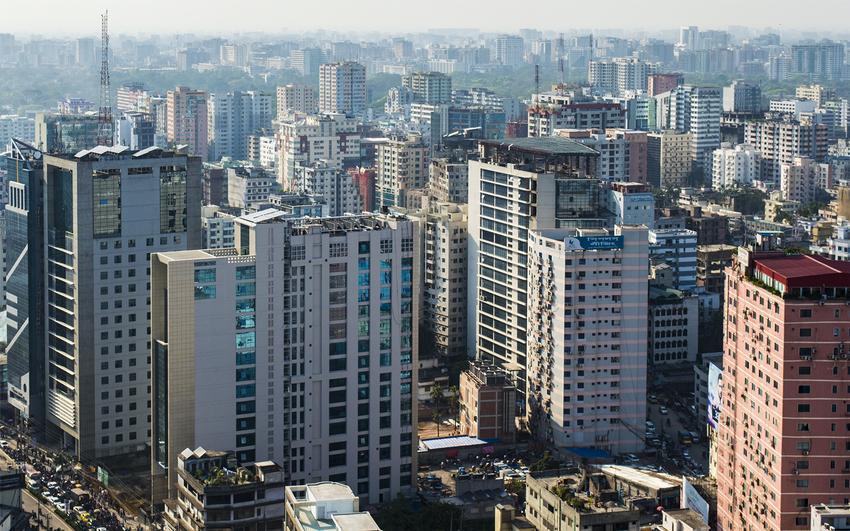
Tiffiny
1 year agoCarlton
1 year ago